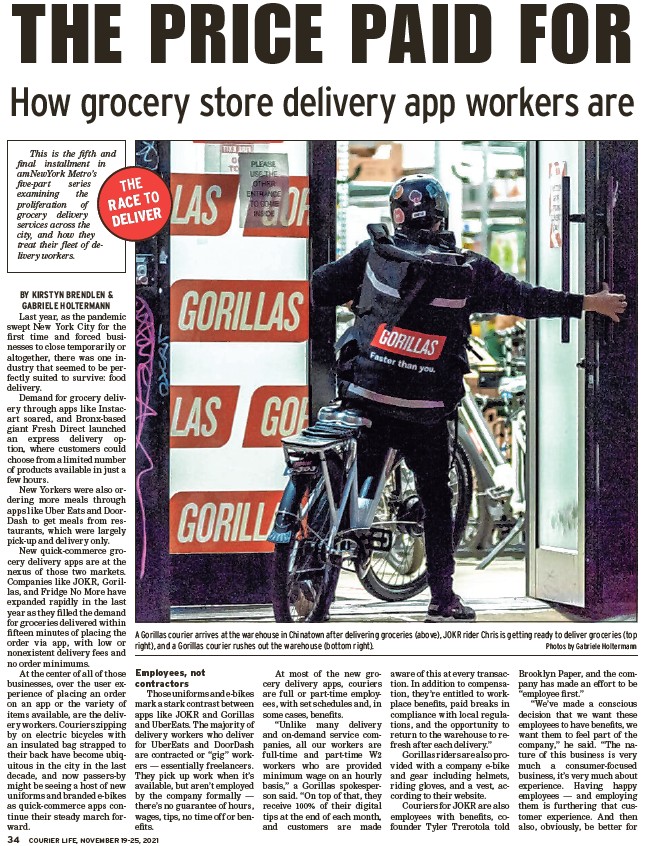
THE PRICE PAID FOR
How grocery store delivery app workers are
BY KIRSTYN BRENDLEN &
GABRIELE HOLTERMANN
Last year, as the pandemic
swept New York City for the
fi rst time and forced businesses
to close temporarily or
altogether, there was one industry
that seemed to be perfectly
suited to survive: food
delivery.
Demand for grocery delivery
through apps like Instacart
soared, and Bronx-based
giant Fresh Direct launched
an express delivery option,
where customers could
choose from a limited number
of products available in just a
few hours.
New Yorkers were also ordering
more meals through
apps like Uber Eats and Door-
Dash to get meals from restaurants,
which were largely
pick-up and delivery only.
New quick-commerce grocery
delivery apps are at the
nexus of those two markets.
Companies like JOKR, Gorillas,
and Fridge No More have
expanded rapidly in the last
year as they fi lled the demand
for groceries delivered within
fi fteen minutes of placing the
order via app, with low or
nonexistent delivery fees and
no order minimums.
At the center of all of those
businesses, over the user experience
of placing an order
on an app or the variety of
items available, are the delivery
workers. Couriers zipping
by on electric bicycles with
an insulated bag strapped to
their back have become ubiquitous
in the city in the last
decade, and now passers-by
might be seeing a host of new
uniforms and branded e-bikes
as quick-commerce apps continue
their steady march forward.
A Gorillas courier arrives at the warehouse in Chinatown after delivering groceries (above), JOKR rider Chris is getting ready to deliver groceries (top
right), and a Gorillas courier rushes out the warehouse (bottom right). Photos by Gabriele Holtermann
Employees, not
contractors
Those uniforms and e-bikes
mark a stark contrast between
apps like JOKR and Gorillas
and UberEats. The majority of
delivery workers who deliver
for UberEats and DoorDash
are contracted or “gig” workers
— essentially freelancers.
They pick up work when it’s
available, but aren’t employed
by the company formally —
there’s no guarantee of hours,
wages, tips, no time off or benefi
ts.
COURIER LIFE, N 34 OVEMBER 19-25, 2021
At most of the new grocery
delivery apps, couriers
are full or part-time employees,
with set schedules and, in
some cases, benefi ts.
“Unlike many delivery
and on-demand service companies,
all our workers are
full-time and part-time W2
workers who are provided
minimum wage on an hourly
basis,” a Gorillas spokesperson
said. “On top of that, they
receive 100% of their digital
tips at the end of each month,
and customers are made
aware of this at every transaction.
In addition to compensation,
they’re entitled to workplace
benefi ts, paid breaks in
compliance with local regulations,
and the opportunity to
return to the warehouse to refresh
after each delivery.”
Gorillas riders are also provided
with a company e-bike
and gear including helmets,
riding gloves, and a vest, according
to their website.
Couriers for JOKR are also
employees with benefi ts, cofounder
Tyler Trerotola told
Brooklyn Paper, and the company
has made an effort to be
“employee fi rst.”
“We’ve made a conscious
decision that we want these
employees to have benefi ts, we
want them to feel part of the
company,” he said. “The nature
of this business is very
much a consumer-focused
business, it’s very much about
experience. Having happy
employees — and employing
them is furthering that customer
experience. And then
also, obviously, be better for
This is the fi fth and
fi nal installment in
amNewYork Metro’s
fi ve-part series
examining the
proliferation of
grocery delivery
services across the
city, and how they
treat their fl eet of delivery
workers.
THE
RACE RACE TO TO
DELIVER